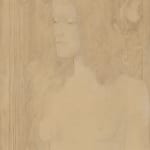Jan Toorop (1858-1928)
Soon after returning to the Netherlands, Toorop cofounded the Haagse Kunstkring (Art Circle of The Hague), where he organized the first retrospective exhibition of Vincent van Gogh (1853-1890) followed by a group show of Les XX in 1892. That same year, Sar Péladan (1858-1918) visited The Netherlands, luring Toorop to join his Salon de la Rose+Croix and ushering in his foray into symbolism. Soon, seductive, fatal women, symbols of sensuality and destroyer of man, entered Toorop’s emblematic vocabulary. Embracing his colonial East Indies heritage of tropical vegetation, carvings and Hindu iconography, Toorop began his most important symbolist drawing The Three Brides, now in the Kröller-Müller Museum, Otterlo. After its completion in 1893, Toorop returned to portraiture, employing his personal symbolism: the soul is revealed in a fantasy, embodying different types of beings rather than the formality of a portrait. The sitter no longer represents a particular woman, but rather the embodiment of a melancholic mood. The androgynous knight in armor in the background is a motif that made its appearance in Fernand Khnopff’s Angel in 1889.
Although Gustav Klimt most likely never met Toorop in person, the Austrian artist was seemingly affected by his Dutch contemporary, whose work he encountered at international exhibitions like the Secession in Vienna. Toorop, participating in Viennese exhibitions from 1899 through 1902, was one of the most celebrated international artists at the turn of the century. While Nirvana was never exhibited in Vienna, it would likely have been familiar to Klimt from the reproduction in Die Kunst für Alle, the influential German magazine in 1898. Klimt’s Bleiches Gesicht (Pale Face) from 1903, heavily borrows the three-quarter length cropping of the woman, the sharp contours as well as the spiritual embodiment of the subject’s physiognomy. Crucial for the expression of reflection and meditation in both works are deep shadows around the eyes and the inward-directed gaze beneath heavy, half-lowered eyelids. Both faces are strikingly similar with the pointy chins, angular noses, and tightly closed lips. Both faces are framed with wavy curly hair, although Toorop’s sparsely use of coloration, the overall translucency of Nirvana is surely sustained.
Provenance
Sotheby's, Amsterdam, 1 December 2004, lot 13Private collection, Germany
Studio 2000, Blaricum, 2012
Private collection, New York
Exhibitions
Brussels, La Libre Esthétique, 25 February - 1 April 1897, no. 496 as Inward Contemplation
Frankfurt, Schirn Kunsthalle, Okkultismus und Avantgarde. Von Munch bis Mondrian 1900-1915, 3 June – 20 August 1995
Zeist, Slot Zeist, Jan Toorop, 15 October 1995 – 7 January 1996
Takamatsu, City Museum of Fine Arts, Symbolisme en Europe, 1 November – 8 December 1996, cat.no. 82, p. 122;
Tokyo, Bunkamura Museum of Fine Arts, 14 December 1996 - 9 February 1997;
Himeij, City Museum of Art, 15 February - 30 March 1997.
Katwijk, Katwijks Museum, Jan Toorop. Het Late Symbolisme, 23 October 2001 - 19 January 2002, no. 23
Domburg, Jan Toorop: Sporen van een Leven, 2005
The Hague, Gemeentemuseum, Toorop in Wenen: Inspiratie voor Klimt, 7 October 2006 - 7 January 2007, fig. 47, p. 40, cat.no. 121, pp. 223-225
The Hague, Gemeentemuseum, Jan Toorop, 26 February - 29 May 2016, cat.no. 189
Hamburg, Hamburger Kunsthalle, Femme Fatale: Gaze – Power – Gender, 9 December 2022 – 10 April 2023
Literature
Paul Schultze-Naumberg, “Jan Toorop”, Die Kunst für Alle, 13, 1897/1898, no. 6, p. 91, ill.
Ph. Zilcken, “Jan Toorop”, Elsevier’s geïllustreerd maandschrift, 8, 1898, Vol. 1, p. 126
Albert Plasschaert, Jan Toorop, Amsterdam 1925, p. 36, no. 1[1]
B. Polak, Het fin de siècle in de Nederlandse schilderkunst, The Hague 1955, pp. 130-131 (Bettina Spaanstra-Polak, Het Symbolisme in de Nederlandse schilderkunst 1890-1900, Bussum 2004)
Phil Mertens, “De brieven van Jan Toorop aan Octave Maus”, in: Bulletin, Musées Royaux des Beaux-Arts de Belgique, 1969 Nos. 3/4, p. 195
Marty Bax, “Theosophie und Kunst in den Niederlanden 1880-1915”, in: Okkultismus und Avantgarde. Von Munch bis Mondrian 1900-1915, 1995, p. 282, fig. 226, p. 295
Catherine de Croës, François Daulte, a.o., Symbolisme en Europe, Tokyo 1996, cat.no. 82, p. 122
William Rothuizen, Jan Toorop in zijn tijd, Amsterdam 1998, cover ill., p. 17 ill.
Harry J. Kraaij & William Rothuizen, Jan Toorop: Het late Symbolisme, Amsterdam 2001 p. 17, ill., p. 36
M. Bisanz-Prakken, Toorop/Klimt. Toorop in Wenen: Inspiratie voor Klimt, exh.cat. Gemeentemuseum, The Hague 2005, cat.no. 121, p. 225
Marian Bisanz-Prakken, in: Gustav Klimt. The Ronald S. Lauder and Serge Sabarsky collections, exh.cat. Neue Galerie, New York 2007, pp. 257-258, ill.
Rosina Neginsky, a.o., Symbolism, Its Origins and Its Consequences, Newcastle upon Tyne 2010, fig. 2-10, p. 42
Pierre Sanchez, Le Salon des XX et de la Libre Esthetique. Repertoire des Exposants et liste de leurs oeuvres. Bruxelles 1884-1914, Dijon 2012, p. 369
Gerard van Wezel, Jan Toorop. Zang der Tijden, The Hague 2016, no. 189, p. 113
Gerard van Wezel, Jan Toorop. Gesang der Zeiten, Munich 2016, cat.no. 200, p. 119
[1] As ‘vrouw (op achtergrond nog een vrouw)’ (woman (another woman in the background)drawing



